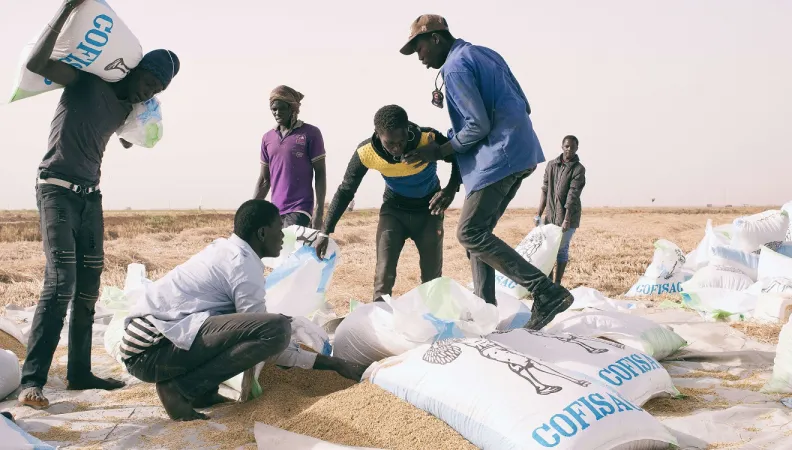Share the page
“The Goal of Zero Hunger by 2030 will be hard to Achieve”
Published on

War, climate change, droughts, and other weather events are all making the struggle to end hunger and malnutrition even more difficult. In this interview, Matthieu Le Grix, head of AFD’s Agriculture, Rural Development and Biodiversity Department, warns us that food security is deteriorating in many parts of the world.
Zero chance of Zero Hunger by 2030
With the war in Ukraine, Covid and rising commodity prices, are the threats to food security multiplying?
The food situation around the world has been deteriorating sharply since 2014. There are various underlying causes for this: conflicts, increasing climatic instability, and degradation of natural resources—especially of soil fertility in Africa. Then, the Covid-19 crisis came along and exacerbated this already downward trend: it destabilized supply chains and limited the movement of people, livestock, and agricultural products. As a result, food insecurity comes on top of an already critical situation.
The war in Ukraine has made circumstances even worse, as it’s heavily affecting cereal prices for the countries that import wheat from Ukraine and Russia. For Africa, where the share of wheat in the diet is very low compared to other locally produced products, the impact from the surge in wheat prices needs to be put into perspective. On the other hand, it’s a real concern for regions such as North Africa and the Middle East.
See also: Ukrainian war worsens African food crisis
Above all, the war has led to an increase in the price of fertilizers, some of which are produced in Russia and in Belarus, and whose prices are linked to those of energy. In fact, farmers in the Sudan-Sahelian region are expecting 2022 harvests to be significantly lower because they don’t have access to the amount of fertilizer they usually use. The 2023 lean season—the period between the end of the previous year’s stocks and the availability of the new crop—is likely to be very difficult.
Food security is also a question of access. It’s not enough just to have a sufficient amount of products available in a country: people there must also be able to obtain them, in both urban and rural areas. And, here too, we’re seeing problems multiply, both because of the impact of the health crisis and the high inflation that has followed. As a result, the United Nations Sustainable Development Goal to achieve “zero hunger” by 2030 will be difficult to achieve.
How is AFD taking action on this issue?
Agriculture and rural development are a long-standing sector in AFD’s work to reduce hunger. One of our approaches is to improve farmers’ incomes and standard of living by improving production capacity. But we also take a more integrated rural development approach, so that rural populations have access to basic services and to more sustainably managed natural resources.
AFD is firmly committed to tackling food insecurity. In recent years, we’ve spent an average of between €400 and €500 million on projects that target food security in the countries where we operate.
See also: AFD and agriculture, rural development and biodiversity
In 2021 we drew up the “Food in Common” initiative, which is dedicated to these issues. It was based on the observation that AFD needed to do more for projects that contribute more directly to food security. With this initiative, our financing focuses more on the production of basic products that are consumed in the countries where we operate, as well as on their availability through storage systems.
Such food stability also means being better prepared and more resilient to shocks, from climate events or pests, for example. We’ve been working for years on locust-crisis prevention systems in West Africa, and now we’re doing the same in East Africa. We also support access to food through social safety nets targeting populations that are vulnerable to food insecurity. Additionally, we give priority to agroecology and the sustainability of production systems by providing support for the agroecological transition.
Could you give us some examples?
In Senegal, we’re supporting the development of irrigation and irrigated rice production in the Senegal River Delta. The goal is to reduce Senegal’s rice imports and improve its food self-sufficiency. We’re also working on the issue of land management and pastoralism.
Meanwhile, in semi-arid zones in Niger, we’re financing the Pasam Household Food Security Support Project, which puts into action agroecology-based solutions to the silting of oasis basins. These include vegetation cover, hedges, crop association, and better irrigation. This project, implemented by the NGO Karkara, comes within the framework of the Great Green Wall (GGW), a huge initiative for ecological restoration and the struggle to reduce food insecurity in the Sahelian belt.
See also: The Great Green Wall: restoring land in Africa
I could also mention the project to support the storage policy of the Economic Community of West African States (ECOWAS). The idea is to provide guidance for a regional policy to encourage solidarity between Member States by setting up a multi-tiered storage strategy. Droughts don’t occur everywhere at the same time, so regional solidarity can play a role.
